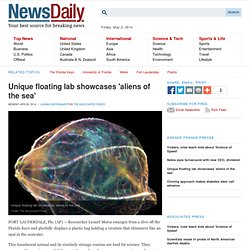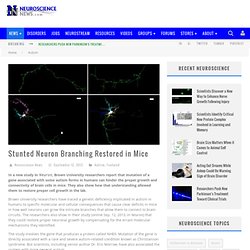

Scientists unveil first wiring diagram of mouse's brain. Last Updated: 2014-04-02 15:46:53 -0400 (Reuters Health) By Sharon Begley WASHINGTON (Reuters) - A year to the day after U.S.

President Barack Obama announced a $100 million "BRAIN Initiative" to accelerate discoveries in how gray matter thinks, feels, remembers, and sometimes succumbs to devastating diseases, scientists on Wednesday said they had achieved a key milestone toward that goal. Writing in the journal Nature, they unveiled the mouse 'connectome,' a map showing the sinuous connections that neurons make throughout the mouse brain as they form functional circuits. The mouse connectome "provides the most detailed analysis of brain circuitry currently available for any mammalian brain," said neuroscientist David Van Essen of Washington University in St. A connectome is essentially a wiring diagram. Such a diagram could reveal, say, how neurons that register the taste of a cookie fan out to circuits that store memories and unleash a torrent of remembrances of things past.
Unique floating lab showcases 'aliens of the sea' FORT LAUDERDALE, Fla.

(AP) — Researcher Leonid Moroz emerges from a dive off the Florida Keys and gleefully displays a plastic bag holding a creature that shimmers like an opal in the seawater. This translucent animal and its similarly strange cousins are food for science. They regrow with amazing speed if they get chopped up. Some even regenerate a rudimentary brain.
"Meet the aliens of the sea," the neurobiologist at the University of Florida says with a huge grin. They're headed for his unique floating laboratory. Moroz is on a quest to decode the genomic blueprints of fragile marine life, like these mysterious comb jellies, in real time — on board the ship where they were caught — so he can learn which genes switch on and off as the animals perform such tasks as regeneration. No white coats needed here. Inside, researchers in flip-flops operate a state-of-the-art genomic sequencing machine secured to a tilting tabletop that bobs with rough waves. Stunted Neuron Branching Restored in Mice. In a new study in Neuron, Brown University researchers report that mutation of a gene associated with some autism forms in humans can hinder the proper growth and connectivity of brain cells in mice.

They also show how that understanding allowed them to restore proper cell growth in the lab. Brown University researchers have traced a genetic deficiency implicated in autism in humans to specific molecular and cellular consequences that cause clear deficits in mice in how well neurons can grow the intricate branches that allow them to connect to brain circuits. The researchers also show in their study (online Sep. 12, 2013, in Neuron) that they could restore proper neuronal growth by compensating for the errant molecular mechanisms they identified. The study involves the gene that produces a protein called NHE6. Mutation of the gene is directly associated with a rare and severe autism-related condition known as Christianson syndrome.
Meet the small yellow worm that can REGROW its own head - and its old memories. If the planarian worm's head is cut off it can regenerate a new oneScientists have found this new head contains memories from the old oneThis suggests memories are stored in another part of the body By Victoria Woollaston Published: 14:19 GMT, 11 July 2013 | Updated: 16:26 GMT, 11 July 2013 Scientists have discovered that not only can the planarian worm regrow its head if its cut off, the regenerated brain contains the same memories that were stored in the decapitated one.

Researchers from Tufts University in Boston tested the memory of the planarian worms by measuring how long it took them to reach food in a lab environment. The small yellow worms had been trained to ignore the bright lights in the lab so they could find their meals without being distracted and the scientists found that even after decapitation worms remembered this training. Small, yellowish planarian worms are found in many parts of the world. They live in both saltwater and freshwater ponds and rivers. Insane in the Chromatophores. Canine Cognition: Brain Scans Reveal Dog's Thoughts. Fido's expressive face, including those longing puppy-dog eyes, may lead owners to wonder what exactly is going on in that doggy's head.

Scientists decided to find out, using brain scans to explore the minds of our canine friends. The researchers, who detailed their findings May 2 in the open-access journal PLoS ONE, were interested in understanding the human-dog relationship from the four-legged perspective. "When we saw those first [brain] images, it was unlike anything else," said lead researcher Gregory Berns in a video interview posted online. "Nobody, as far as I know, had ever captured images of a dog's brain that wasn't sedated. This was [a] fully awake, unrestrained dog, here we have a picture for the first time ever of her brain," added Berns, who is director of the Emory University Center for Neuropolicy.
He added, "Now we can really begin to understand what dogs are thinking. Sit … stay … still Mirror into human mind. Simulated brain scores top test marks.